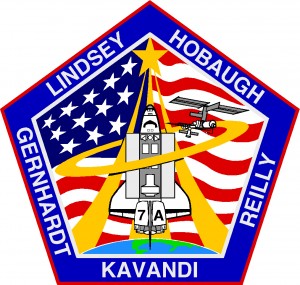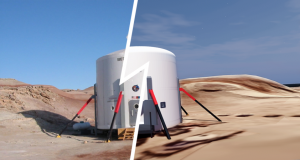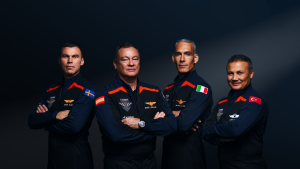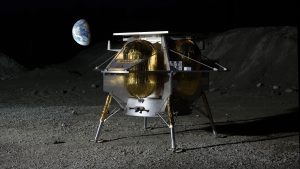Expedition 2

Day One of Expedition 2 started with some excitement when a fire alarm went off. This automatically shut down the ventilation system to slow the spread of smoke. It turned out to be a false alarm and Houston restarted the fans. Several computers had also gone down and it took longer to determine the cause.
While attempting to activate the Ku-Band antenna which would improve bandwidth for the expanded science program, a pointing error in the antenna was discovered. The crew deactivated it to wait for a software patch to be written, tested and uploaded. To insure that no data was lost during the delay, it was simply saved on computer disks until they had a chance to transmit it. The crew also had to troubleshoot a malfunctioning condensate venting system on Destiny and Usachev replaced a pump in the carbon dioxide removal system.
Huntsville made some updates to Payload Computers 1 and 2 to assist with Expedition 2’s expanded science program. Usachev, Voss and Helms had already begun some biomedical experiments that would monitor their adjustment to weightless conditions. Experiments also included “astroculture,” the study of plants in space, that involved determining whether a relative of cabbage could complete its seed-to-seed life cycle in space, and the Bonner Ball Neutron Detector, which would measure neutron radiation on the space station. Some experiments, like the ESA’s Dosimetric Mapping project, would also measure the radiation that got into the station and help determine the feasibility of long-term space missions like a proposed mission to Mars that had been on the drawing board for a while. Behaviourists were also interested in studying personal and cultural interactions on the space station, so the crew routinely filled out questionnaires for the Interaction Experiment.
Others might have practical applications on Earth, like an Experiment of Physics of Colloids in Space, which would study the action of tiny particles suspended in a liquid and could lead to improved fluid-based products like paints and ink. An especially interesting project for the crew was photographing areas on Earth for the Crew Earth Observation experiment, which began with Voss photographing the Parana River Basin in Paragray. In a first for the space program, students in middle school would get a chance to control a digital camera mounted to one of Zarya’s observation windows to take pictures of Earth in the “Earth Knowledge Acquired By Middle School Experiment” (EarthKAM).
As part of the preparations for the arrival of STS-100 in late April, the station crew loaded up Progress-M 44 with garbage. This was another Russian spacecraft destined to burn up in Earth’s atmosphere. They also had to relocate the Soyuz from Zarya’s nadir docking port to Zvezda’s wake docking system.

In April 2001, NASA announced that it was discussing a new Habitation Module with the Italian Space Agency. The Habitation Module would hold four astronauts and would replace a US Habitation Module that had been canceled. The contract would involved providing more time on the ISS for Italian astronauts and experiments. This helped insure that NASA wouldn’t have to transfer funds but didn’t help the threatened X-38 Crew Return Vehicle. Two Soyuz vehicles would take care of the return needs of a crew of six but NASA preferred that the ESA develop a new vehicle if they couldn’t. The ESA wanted its spaceflight capability to become more independent and was happy to look into an option that could be launched on its Ariane V rocket.
ISS’s First Space Tourist
In December 2000, the Russians announced that Dennis Tito had paid $20 million to Mircorp to become the first “space tourist” to the International Space Station. The original plan had been to fly him to Mir but this changed when Mir was deorbited. The partners weren’t very happy with the idea of having a private citizen on the space station and only agreed to it when the Russians agreed that Tito would stay on Zvezda and Zarya, only visit other parts of the station with an escort and pay for any damage he caused. He trained for 900 hours for his flight on Soyuz-TMA 32, commanded by Talgat Musabayev with Flight Engineer Yuri Baturin. Tito volunteered to take on some of the menial tasks to free up time for the professional astronauts and cosmonauts on board. He reported that the American astronauts were cordial and had given him a complete tour of the station. Even so, the Russian cosmonauts on the Soyuz crew complained that the Americans had apparently been told not to be seen associating with Tito. A NASA spokesman explained that the crew was still getting things back in order after the STS-100 visit, as well as working on experiments and making the switch between Soyuz 31 and 32 as a return to Earth vehicle, and didn’t have a lot of time to spend entertaining a visitor. Facing pressure from the partners over having an untrained visitor on the International Space Station, the Russian Space Agency went into damage control mode and agreed not to send any more paying space travelers up to the space station for at least two years.
After switching seats between the two Soyuz vehicles attached to the station, the Soyuz visitors returned home in Soyuz 31. Soyuz 32 had become the Expedition 2 crew’s new ride home if they had to evacuate. With their departure, the station crew took a day and a half off, and then returned to work. They assembled a new computer that could serve as a backup if another of the Command and Control computers went down. C&C-2 was the current primary computer with C&C-1 acting as backup. The crew removed the disk from C&C-3 and made their newly assembled computer the second backup. The computer controlling Canadarm2 was also having intermittent software issues. Canadian computer experts were busy writing a patch and NASA planned an EVA in case it became necessary to replace the affected computer in Canadarm2. Spare computer parts were added to the manifest of Progress-MI 6.
The Progress launched on May 20th and delivered propellant for the station’s propulsion system, along with new computer parts and experiments. The colloid experiment failed to start. The uploaded software update for Canadarm2’s computer also failed, canceling a planned dress rehearsal for using Canadarm2 to help transfer a new Joint Airlock Module from STS-104 to Unity. Until they could solve the problem, the launch of STS-104 was delayed to July. This had a snowball effect that also pushed back STS-105. After a few more tries to update the software, Canadarm2 engineers decided that the most likely cause of the problem was a faulty computer chip. A software patch was written to instruct Canadarm2 to ignore commands from that chip and Voss successfully tested the arm with the series of maneuvers planned for the next space shuttle mission.

A test of the Kurs automatic rendezvous and docking system turned up some problems, leading to an “internal EVA” in which Usachev and Voss, wearing Russian-built spacesuits, entered Zvezda’s forward docking compartment and sealed themselves inside. The compartment was depressurized and the two crewmen removed the cover and replaced it with a conical docking drogue from the axial port. They locked the 12 latches into place. Although neither man actually went outside, it was called the first EVA by station astronauts with no shuttle in place.
As Expedition 2 wound down, NASA had some explaining to do. Some equipment had been more expensive than expected, leading to cost overruns. Budget issues had also forced NASA to cancel 40% of the planned scientific activity on the International Space Station. Also under fire was an exclusive contract to Boeing, which NASA had failed to explain adequately. On the upside, the House Appropriations Committee was considering a plan to reinstate funding for the X-38 Crew Return Vehicle to go with Italy’s Habitation Module.
In the meantime, Expedition 2 was getting their schedule back on track after the visit of STS-104. While performing maintenance on the ARIS apparatus used to measure vibrations on the space station, Voss replaced a malfunctioning actuator and a push rod and then tested it with a small hammer. The scientific control team in Huntsville began preparations to switch over to Expedition 3. NASA studied the possibility of upgrading the Extended Duration Orbiter’s cyrogenic fluids package to allow the space shuttle to stay docked for longer periods of time for joint activity. There was talk of decommissioning the space shuttle Columbia, which flew “solo” missions not involved with the space station, to save money. Russia was preparing its next Progress cargo shipment and a Russian Docking Compartment.
The problems with the Command and Control computers continued when C&C-1’s hard drive went down. A reboot from Houston failed to solve the problem. The cargo on STS-105 would include a spare computer and the remaining two C&C computers continued to function, so the issue was not considered critical.
Astrophotography from Space
Jealous? If you’re into astrophotography, you should be. The astronauts on the International Space Station don’t have a pesky and unreliable atmosphere in the way.
International Space Station Collectibles on eBay





